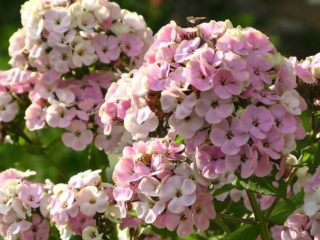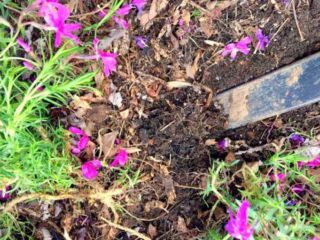Content
Phlox Zenobia is a fabulous flower with an extensive palette and inflorescence structure, recently discovered by Dutch breeders. The variety is new, unpretentious, hardy and does not require special care, surprises with its unusual flowering and splendor. Suitable for transplanting in any season, even during active growth.
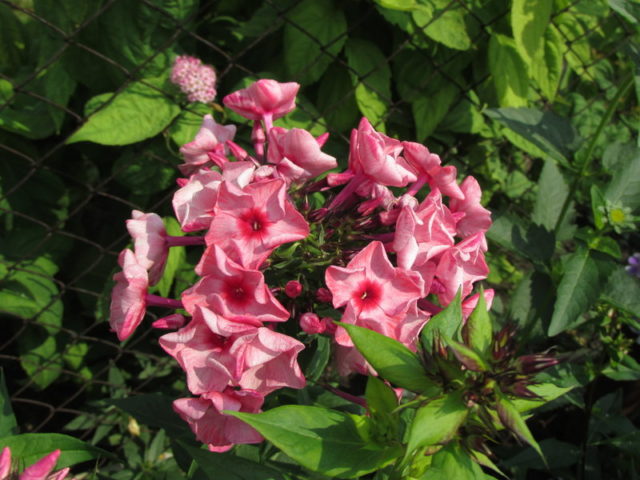
Phlox "Zenobia" has a very interesting and unusual structure of inflorescences
Description of phlox Zenobia
Zenobia is an ornamental sun-loving phlox variety. Prefers to grow in a cool place. The bushes are moderately spreading, can reach 80 cm. Stems are erect, ascending, sometimes creeping, have different heights, from 20 to 70 cm. Leaves are elongated or lanceolate, have a rich green color with a maroon tint.
Phlox "Zenobia" blooms once a year, abundantly. It grows quickly. Propagated by cuttings, seeds or dividing the bush.
The variety is winter-hardy, capable of withstanding a drop in temperature to -29 °C. Recommended for cultivation in most of Russia, cities with a temperate climate, in the Far East, in the southern regions of Siberia and the Moscow region.
Flowering features
Phlox "Zenobia" (Zenobia) is a perennial variety, belongs to the paniculate group. Long flowering. With proper care, the inflorescences of the plants will decorate the flower garden from June to September. Phlox buds of this variety are pink, blue, white, red, lilac or carmine with an eye in the middle. Many phlox growers call the variety a chameleon because the color of the inflorescences changes at different stages of growth. The flowers have a very fragrant aroma, after opening they take on an interesting shape. Usually they are collected in paniculate, less often in corymbose inflorescences of various structures and sizes. The size of the flower can reach 4 cm, the petals curl and bend in different directions.
The splendor of flowering is influenced by the location and composition of the land. The Zenobia variety feels best in sunlit flower beds, on clay soil fertilized with organic matter.
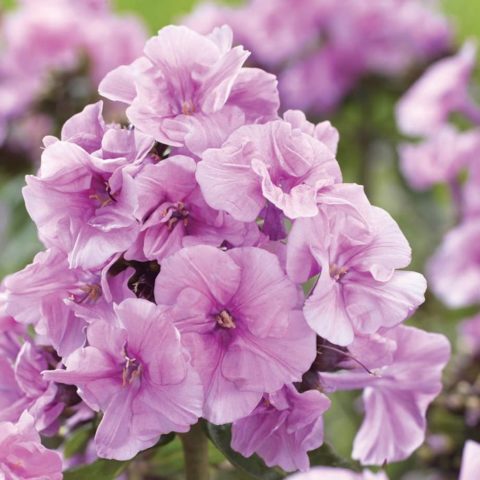
The variety can take root on any soil, but the best option for growing is loamy soil.
Application in design
The phlox variety "Zenobia" takes root well and grows in almost any flower garden, but since the plant occupies a large amount of land, its cultivation in flowerpots, boxes or on the balcony is not reasonable.
In a flower bed it looks great with geraniums, lilies, alpine asters and carnations. The bush can be planted in the central part or in the corner of the composition. The neighborhood with marigolds will save the flower from the nematode. The only thing that should not be planted nearby are aggressor plants: loosestrife, highlander, lily of the valley and others.
Reproduction methods
Since paniculata phlox Zenobia grows rapidly, it is very easy to propagate. This can be done in different ways: bush division, stem cuttings, seeds. The most effective and simple technology is considered to be by dividing the bush. Moreover, for the preservation of the decorative qualities of the plant, once every 3 years, it is necessary to carry out a rejuvenation procedure, which just consists in its division.
Landing rules
Phlox varieties "Zenobia" are planted at any time when the need arises. Under favorable conditions, the plant can be divided even during the period of abundant flowering.The main factor for replanting is the presence of a lit area and moist, fresh, loose soil, saturated with nutrients.
Since phlox "Zenobia" are unpretentious plants, planting and propagating them will not be difficult even for a novice gardener. But in order to achieve the maximum result, it is required to provide favorable conditions for their maintenance:
- a sunny area is a guarantee of a bright and abundant flowering of the Zenobia variety;
- nutritious soil - ensuring good growth;
- periodic processing - exclusion of the appearance of diseases and pest infestations.
The most optimal transplanting time for Zenobia phlox, as well as for other varieties of this plant, is spring. All procedures take place in plowed land with the addition of phosphorus flour, superphosphate or manure.
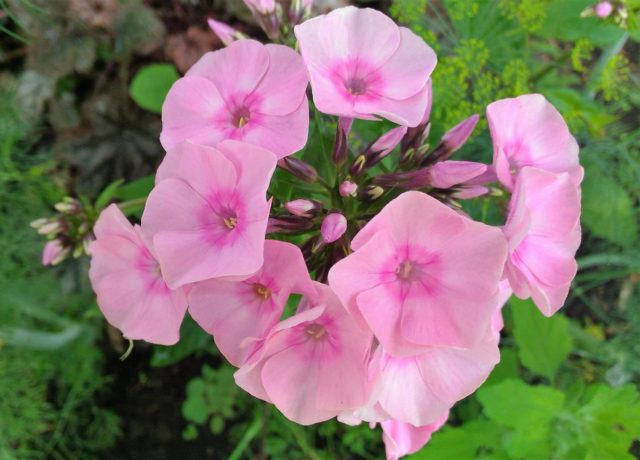
The most affordable way to get a new phlox bush is to divide an adult plant
If Zenobia is planted in the summer, it is necessary that the bush be dug out with a large clod of earth. Also, the plant needs to cut off the tops, but the roots should not be disturbed.
In autumn, it should be borne in mind that during this period buds are laid at the roots of the plant, so the procedure must be performed one and a half months before frost. It is also important to cut the ground part of the bush by at least a third.
The planting of the roots of the culture is carried out to a depth of no more than 15 cm. The site where the Zenobia phlox will grow is pre-dug to a depth of 30-40 cm, and organic fertilizing is introduced into the ground. The bushes are planted so that the distance between them is at least 30 cm. Before planting, the ground is watered abundantly.
Phloxes feel comfortable on "breathing" and moisture-absorbing, light, fertile soil. Slightly acidic and neutral loams are well suited for them. If the requirements are not met, useful components must be added to the proposed planting site:
- It is advisable to enrich poor land with compost, ash or humus.
- Add sand or peat to heavy soil.
- Mix acidic soil with dolomite flour, lime and wood ash.
- It is advisable to add calcium sulfate to soil with a high alkali content.
Follow-up care
The main care of Zenobia paniculate phlox is watering, feeding and loosening the soil. After planting the plant, the soil must be abundantly moistened until the bush takes root and grows. Then watering should be carried out as the earth dries up. After moistening, it is advisable to loosen the soil and remove weeds.
The plant feels good even without fertilizers, but for better flowering, it is advisable to carry out regular feeding (3-5 times a season):
- In spring, flowers need a lot of nitrogen.
- During flowering, phlox will benefit from phosphorus and potassium.
- With the onset of autumn, it is advisable to feed the bushes with minerals, potassium, folk remedies.
At the age of 3 years "Zenobia" needs mulching. It should be carried out after the snow melts and before the onset of cold weather.
Preparing for winter
When Zenobia stops blooming, it's time to prune and prepare for winter:
- In September, the plant is treated with fungicides.
- In early October, the bushes are pruned at a distance of 5-8 cm from the ground and spud.
- In the middle of autumn, they are treated with special solutions for fungal infections and various diseases.
- After processing, Zenobia phlox is mulched with peat, humus, cut grass or sawdust.
The plant is frost-resistant and does not need special materials for shelter.
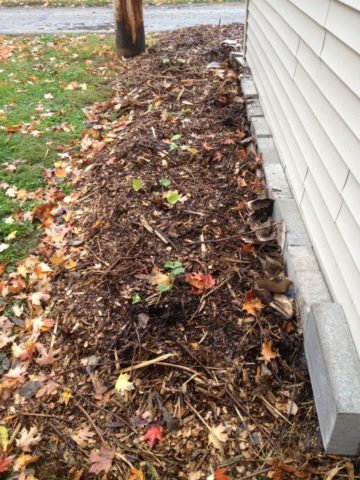
Mulching is necessary to create protection of underground buds from freezing
Pests and diseases
Towards the middle of summer, phloxes often become ill and begin to fade. To prevent such phenomena, it is required to spray them with chemicals at least twice.In addition, you regularly need to weed the flower beds from weeds, which not only prevent the growth of phloxes, but are also carriers of diseases, and also attract pests.
The Zenobia variety can most often be affected by powdery mildew, which is a white bloom on the leaves of the plant. For treatment and prevention, the bushes are recommended to be treated with Bordeaux liquid. At the first sign of infection, spray with soapy water and soda.
Pests that can attack phlox are aphids, nematodes, pennits and thrips. To combat them, insecticides are used.
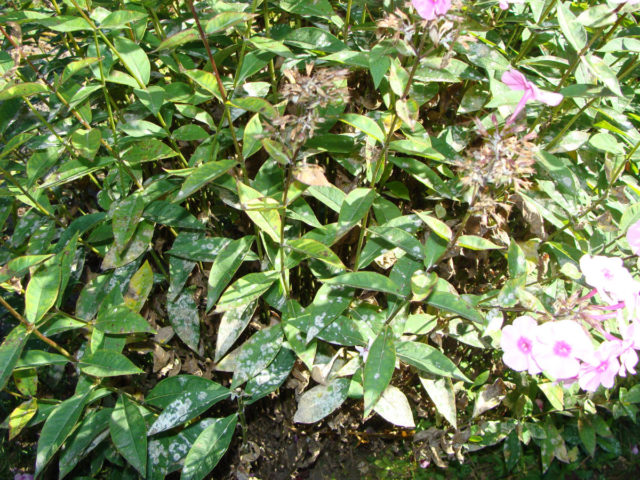
If you notice the disease at an early stage, the plant can be quickly saved without resorting to chemicals.
Conclusion
Phlox Zenobia is a very beautiful variety of flowers that many gardeners love. Growing them requires a little preparation and doesn't cause a lot of hassle. Subject to all the rules for caring for the crop, a spectacular plant will delight with beautiful and abundantly flowering bushes until autumn.




